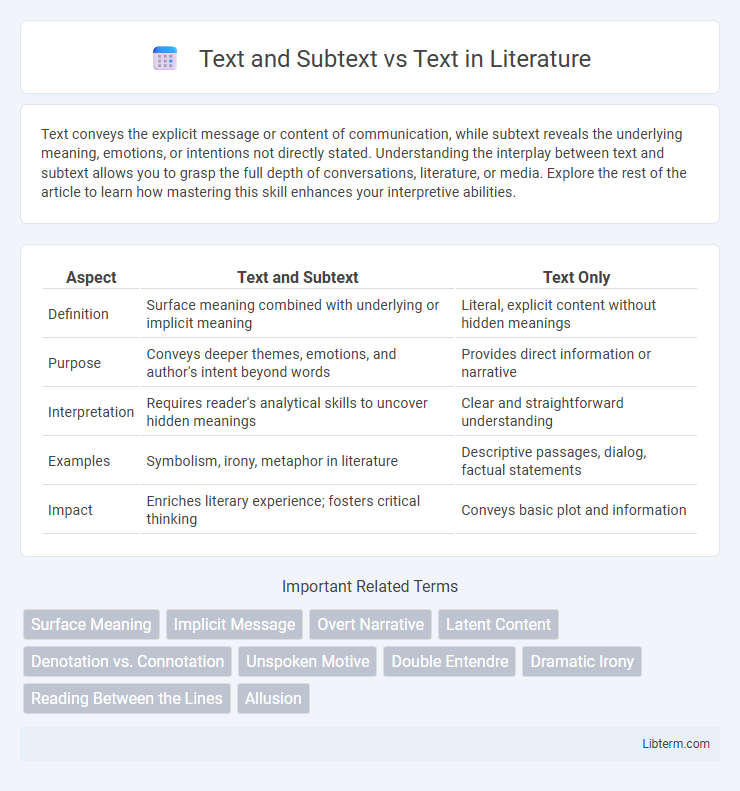Text conveys the explicit message or content of communication, while subtext reveals the underlying meaning, emotions, or intentions not directly stated. Understanding the interplay between text and subtext allows you to grasp the full depth of conversations, literature, or media. Explore the rest of the article to learn how mastering this skill enhances your interpretive abilities.
Table of Comparison
| Aspect | Text and Subtext | Text Only |
|---|---|---|
| Definition | Surface meaning combined with underlying or implicit meaning | Literal, explicit content without hidden meanings |
| Purpose | Conveys deeper themes, emotions, and author's intent beyond words | Provides direct information or narrative |
| Interpretation | Requires reader's analytical skills to uncover hidden meanings | Clear and straightforward understanding |
| Examples | Symbolism, irony, metaphor in literature | Descriptive passages, dialog, factual statements |
| Impact | Enriches literary experience; fosters critical thinking | Conveys basic plot and information |
Understanding Text: The Surface Meaning
Understanding text involves grasping the surface meaning conveyed directly by words and sentences, which presents explicit information without requiring inference. Text represents the literal content that communicates facts, events, or statements, forming the foundation for comprehension before exploring deeper interpretations. Accurately interpreting text ensures clarity in communication and provides a baseline for analyzing subtext or implied messages.
Defining Subtext: Reading Between the Lines
Subtext refers to the underlying meaning or implicit message in a text that is not directly stated but can be inferred through context, tone, and character behavior. It enhances storytelling by revealing characters' true intentions, emotions, and conflicts beyond the literal dialogue or narration. Understanding subtext requires critical reading skills and attention to nuance, allowing readers to grasp deeper layers of meaning embedded in literary works.
Key Differences: Text vs. Subtext
Text refers to the explicit content or literal meaning within written or spoken communication, representing what is directly stated. Subtext encompasses the underlying messages, emotions, or ideas implied but not explicitly expressed, revealing deeper layers of meaning beyond the surface. The key difference lies in text conveying clear information, while subtext relies on context, tone, and inference to convey hidden or nuanced significance.
The Role of Context in Subtext Interpretation
Context plays a crucial role in interpreting subtext, as it provides the background, situational cues, and emotional undercurrents that reveal meanings beyond the explicit text. Subtext depends heavily on shared knowledge between the speaker and listener, such as cultural references, tone, and nonverbal signals, which allow inferred meanings to emerge. Without context, the subtext can become ambiguous or entirely lost, reducing communication to literal interpretations only.
Importance of Subtext in Communication
Subtext enriches communication by conveying underlying emotions and intentions beyond the explicit text, enabling deeper understanding and connection. It allows speakers and writers to express complex ideas subtly, fostering nuance in interpersonal interactions. Recognizing subtext enhances interpretation skills, making communication more effective and meaningful.
Text and Subtext in Literature and Film
Text and subtext in literature and film operate on dual layers of meaning, where text refers to the explicit dialogue, plot, and visuals presented directly to the audience. Subtext reveals the underlying emotions, themes, and intentions that characters imply but do not openly express, enriching the narrative with deeper psychological or societal insights. Skilled creators use subtext to build complexity and engage viewers or readers in interpreting hidden motives and symbolic nuances beyond the surface story.
Common Misinterpretations: When Subtext is Missed
Ignoring subtext often leads to a shallow interpretation of communication, where only the literal meaning of the text is considered. This common misinterpretation overlooks hidden emotions, intentions, or cultural nuances embedded beneath the surface of dialogue or narrative. Recognizing subtext enriches understanding by revealing unspoken motivations and deeper layers of meaning, essential in literature, film, and everyday conversations.
Techniques for Crafting Effective Subtext
Techniques for crafting effective subtext involve utilizing indirect communication methods such as implication, suggestion, and nonverbal cues to convey deeper meanings beneath the explicit dialogue. Writers employ strategies like contrast between spoken words and characters' true intentions, symbolism, and context to enrich the narrative with layered interpretations. Mastering subtext enhances storytelling by allowing audiences to infer emotions and themes, creating a more immersive and thought-provoking experience.
Balancing Text and Subtext for Impactful Writing
Balancing text and subtext enhances impactful writing by engaging readers through explicit narrative and underlying meaning. Text conveys the surface story, while subtext adds depth, emotion, and complexity, inviting interpretation beyond the literal words. Writers achieve resonance by skillfully intertwining clear information with subtle cues, enriching the reader's experience and fostering deeper connection.
Real-World Examples: Text and Subtext in Action
In storytelling, text refers to the explicit dialogue or narrative, while subtext conveys underlying meanings and emotions that are not directly stated. A classic example is the film "The Graduate," where the surface conversation between characters hides deeper feelings of confusion and desire evident through body language and tone. Similarly, in literature, Ernest Hemingway's "Hills Like White Elephants" uses sparse dialogue as text while the subtext reveals profound tension about an unspoken abortion.
Text and Subtext Infographic

 libterm.com
libterm.com